The marking scheme for CBSE (Central Board of Secondary Education) class XII Computer Science paper is as follows:
Marking Scheme For CBSE Class XII (Computer Science) 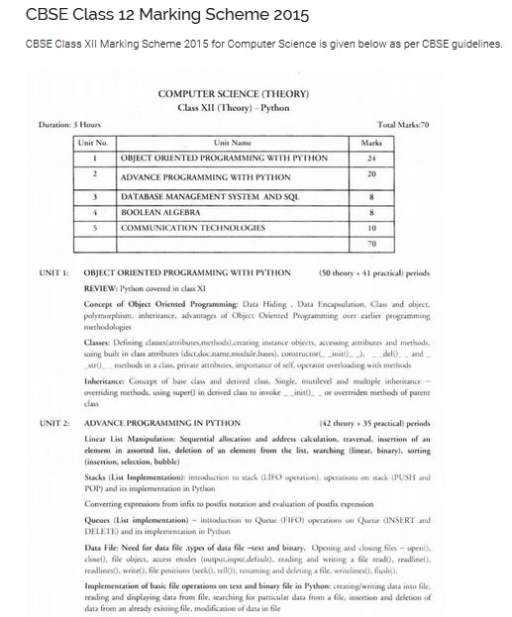

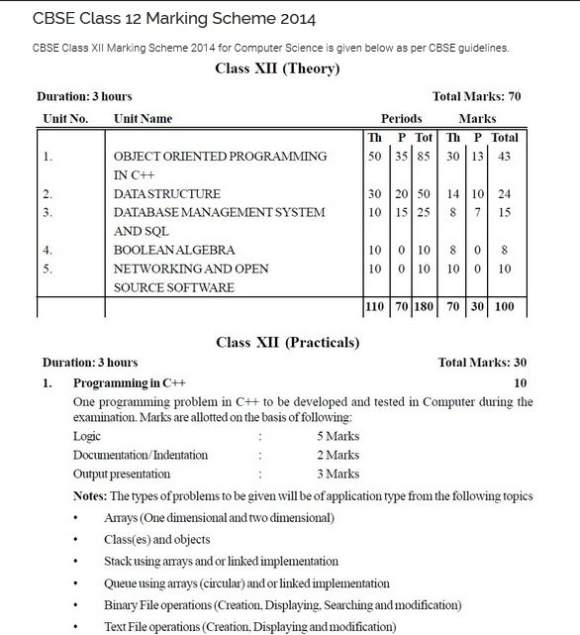
 CBSE Class XII Computer Science Syllabus
CBSE Class XII Computer Science Syllabus
UNIT 1: OBJECT ORIENTED PROGRAMMING IN C++
REVIEW: C++ covered In Class -XI, Object Oriented Programming:
Concept of Object Oriented Programming - Data hiding, Data encapsulation, Class and Object, Abstract class and Concrete class, Polymorphism (Implementation of polymorphism using Function overloading as an example in C++); Inheritance, Advantages of Object Oriented Programming over earlier programming methodologies,
Implementation of Object Oriented Programming concepts in C++:
Definition of a class, Members of a class - Data Members and Member Functions (methods), Using Private and Public visibility modes, default visibility mode (private); Member function definition: inside class definition and outside class definition using scope resolution operator (:

; Declaration of objects as instances of a class; accessing members from object(s), Objects as function arguments - pass by value and pass by reference;
Constructor and Destructor:
Constructor: Special Characteristics, Declaration and Definition of a constructor, Default Constructor, Overloaded Constructors, Copy Constructor, Constructor with default arguments; Destructor: Special Characteristics, Declaration and definition of destructor;
Inheritance (Extending Classes):
Concept of Inheritance, Base Class, Derived Class, Defining derived classes, protected visibility mode; Single level inheritance, Multilevel inheritance and Multiple inheritance, Privately derived, Publicly derived and Protectedly derived class, accessibility of members from objects and within derived class(es);
Data File Handling:
Need for a data file, Types of data files - Text file and Binary file;
Text File : Basic file operations on text file: Creating/Writing text into file, Reading and Manipulation of text from an already existing text File (accessing sequentially); Binary File: Creation of file, Writing data into file, Searching for required data from file, Appending data to a file, Insertion of data in sorted file, Deletion of data from file, Modification of data in a file; Implementation of above mentioned data file handling in C++;
Components of C++ to be used with file handling: Header file:
fstream.h; ifstream, ofstream, fstream classes; Opening a text file in in, out, and app modes;
Using cascading operators (>> <<)for writing text to the file and reading text from the file; open(),
get(), put(), getline() and close() functions; Detecting end-of-file (with or without using eof() function);
Opening a binary file using in, out, and app modes;
open(), read(), write() and close() functions; Detecting end-of-file (with or without using eof()
function); tellg(), tellp(), seekg(), seekp() functions.
Pointers: Introduction to Printer, Declaration and Initialization of Pointers; Dynamic memory allocation/ deallocation operators: new, delete; Pointers and Arrays: Array of Pointers, Pointer to an array (1 dimensional array) Function returning a pointer, Reference variables and use of alias; Function call by reference. Pointer to structures: Deference operator: *, ->; self referencial structures;
UNIT 2: DATA STRUCTURES
Introduction to data structure, primitive and non-primitive data structure, linear and non-linear structure, static and dynamic data structure.
Arrays: One and two Dimensional arrays: Sequential allocation and address calculation;
One dimensional array: Traversal, Searching (Linear, Binary Search), Insertion of an element in an array, deletion of an element from an array, Sorting (Insertion, Selection, Two-dimensional arrays: Traversal, Finding sum/difference of two NxM arrays containing numeric values, Interchanging Row and Column elements in a two dimensional array;
Stack (Array and Linked implementation of Stack):
Operations on Stack (PUSH and POP) and its Implementation in C++, Converting expressions from INFIX to POSTFIX notation and evaluation of Postfix expression;
Queue: (Circular Array and Linked Implementation): Introduction to Queue (FIFO - First in First out operations) Operations on Queue (Insert and Delete) and its Implementation in C++.
UNIT 3: DATABASES AND SQL
Database Concepts: Introduction to data base concepts and its need.
Relational data model: Concept of domain, tuple, relation, key, primary key, alternate key, candidate key;
Relational algebra: Selection, Projection, Union and Cartesian product;
Structured Query Language: General Concepts: Advantages of using SQL, Data Definition Language and Data Manipulation Language;
Data types: NUMBER/DECIMAL, CHARACTER/VARCHAR/VARCHAR2, DATE;
SQL commands: CREATE TABLE, DROP TABLE, ALTER TABLE, UPDATE...SET..., INSERT, DELETE; SELECT, DISTINCT, FROM, WHERE, IN, BETWEEN, GROUP BY, HAVING, ORDER BY;
SQL functions: SUM, AVG, COUNT, MAX and MIN; Obtaining results (SELECT query) from 2 tables using equi-join, Cartesian Product and Union
Note: Implementation of the above mentioned commands could be done on any SQL supported software on one or two tables.
UNIT 4: BOOLEAN ALGEBRA
Role of Logical Operations in Computing.
Binary-valued Quantities, Logical Variable, Logical Constant and Logical Operators: AND, OR, NOT;
Truth Tables; Closure Property, Commutative Law, Associative Law, Identity law, Inverse law, Principle of Duality, Idem potent Law, Distributive Law, Absorption Law, Involution law, DeMorgan's Law and their applications;
Obtaining Sum of Product (SOP) and Product of Sum (POS) form from the Truth Table, Reducing Boolean Expression (SOP and POS) to its minimal form, Use of Karnaugh Map for minimization of Boolean expressions (up to 4 variables);
Application of Computing Logic:
Building up logic circuits using basic Logic Gates (NOT, AND, OR, NAND, NOT)
Use of Boolean operators (NOT, AND, OR) in SQL SELECT statements
Use of Boolean operators (AND, OR) in search engine queries.
UNIT 5: COMMUNICATION AND OPEN SOURCE CONCEPTS COMMUNICATION TECHNOLOGIES
Evolution of Networking: ARPANET, Internet, Interspace Different ways of sending data across the network with reference to switching techniques (Circuit, Message and Packet switching)
Data Communication terminologies: Concept of Channel, Baud, Bandwidth (Hz, KHz, MHz) and Data transfer rate (bps, kbps, Mbps, Gbps, Tbps)
Transmission media: Twisted pair cable, coaxial cable, optical fiber, infrared, radio link, microwave link and satellite link
Network devices: Modem, RJ45 connector, Ethernet Card, Hub, Switch, Gateway
Network Topologies and types: Bus, Star, Tree; PAN, LAN, WAN, MAN
Network Protocol: TCP/IP, File Transfer Protocol (FTP), PPP, Remote Login (Telnet), Internet Wireless/Mobile Communication protocol such as GSM, CDMA, GPRS, WLL, 1G, 2G and 3G Electronic mail protocols such as SMTP, POP3 Protocols for Chat and Video Conferencing VoIP protocols such as Wi-Fi and WiMax
Network Security Concepts: Threats and prevention from Viruses, Worms, Trojan horse, Spams Use of Cookies, Protection using Firewall; India IT Act, Cyber Law, Cyber Crimes, IPR issues, Hacking. WebServices: WWW, Hyper Text Markup Language (HTML), eXtensible Markup Language (XML); Hyper Text Transfer Protocol (HTTP); Domain Names; URL; Protocol Address; Website, Web browser, Web Servers; Web Hosting, Web Scripting - Client side (
VB Script, Java Script, PHP) and Server side (ASP, JSP, PHP), Web 2.0 (for social networking) Open Standards Introduction to open standards and its advantage in development of inter-operable environment. Open Source Concepts Proprietory and Open Source Software, Freeware, Shareware, FLOSS/FOSS, GNU,FSF, OSI, W3C
Practicals:
1. Programming in C++ 10 - One programming problem in C++ to be developed and tested in Computer during the examination. Marks are allotted on the basis of following:
Logic : 5 Marks
Documentation/Indentation : 2 Marks
Output presentation : 3 Marks
Notes: The types of problems to be given will be of application type from the following topics.
Arrays (One dimensional and two dimensional)
Array of structure
Stack using arrays and linked implementation
Queue using arrays (circular) and linked implementation
Binary File operations (Creation, Displaying, Searching and modification)
Text File operations (Creation, Displaying and modification)
2. SQL Commands 05 - Five Query questions based on a particular Table/Reaction to be tested practically on Computer during the examination. The command along with the result must be written in the answer sheet.
3. Project Work 05 - The project has to be developed in C++ language with Object Oriented Technology and also should have use of Data files. (The project is required to be developed in a group of 2-4 students)
Presentation on the computer
Project report (Listing, Sample, Outputs, Documentation
Viva
4. Practical File 05 - Must have minimum 20 programs from the following topics
Arrays (One dimensional and two dimensional, sorting, searching, merging, deletion'& insertion of elements)
Arrays of structures,
Stacks using arrays and linked implementation
Queues using arrays (linear and circular) and linked implementation
File (Binary and Text) operations (Creation, Updation, Query)
Any computational based problems
15 SQL commands along with the output based on any table/relation: 3 Marks
5. Viva Voce 05 - Viva will be asked from syllabus covered in class XII and the project developed by student.


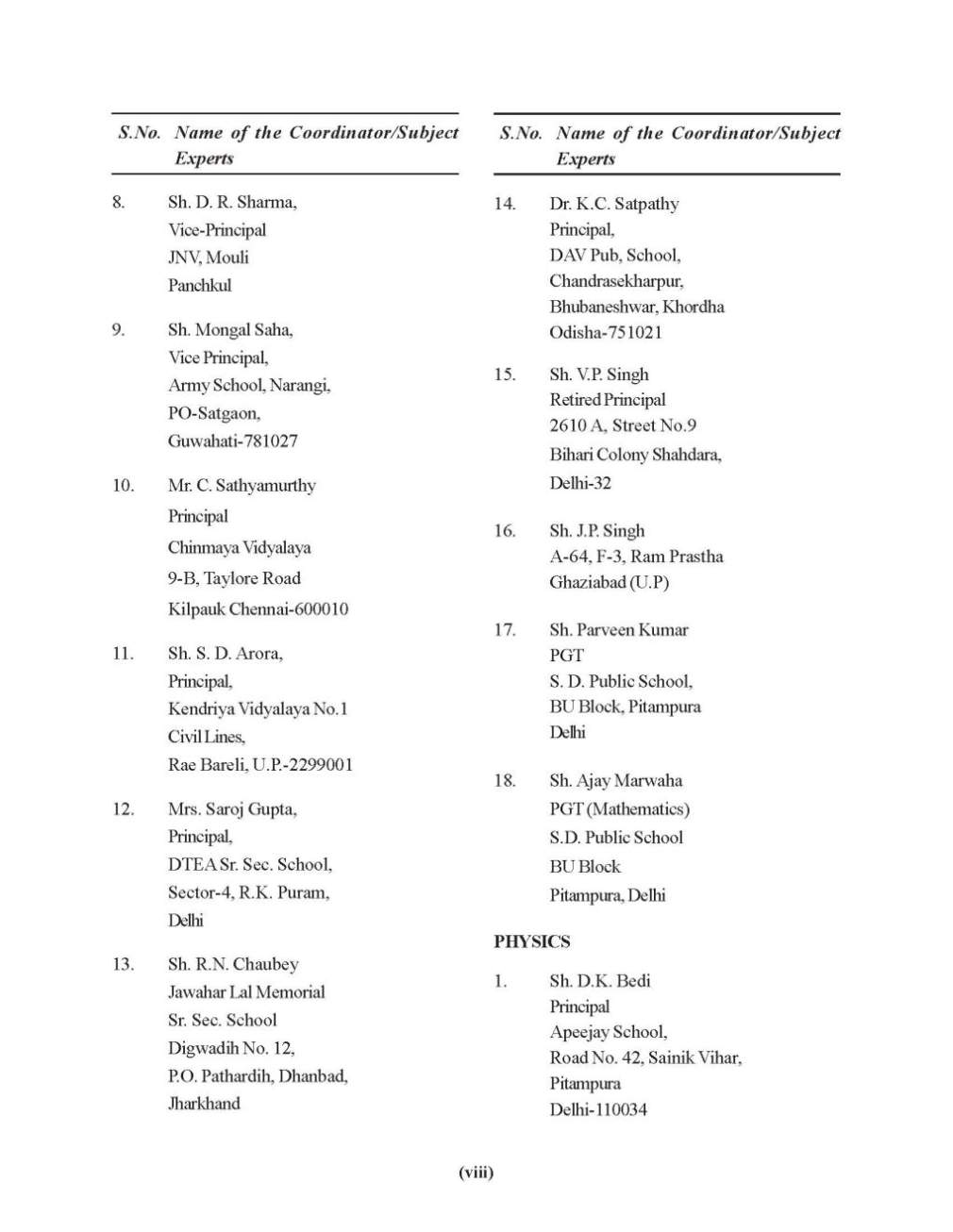
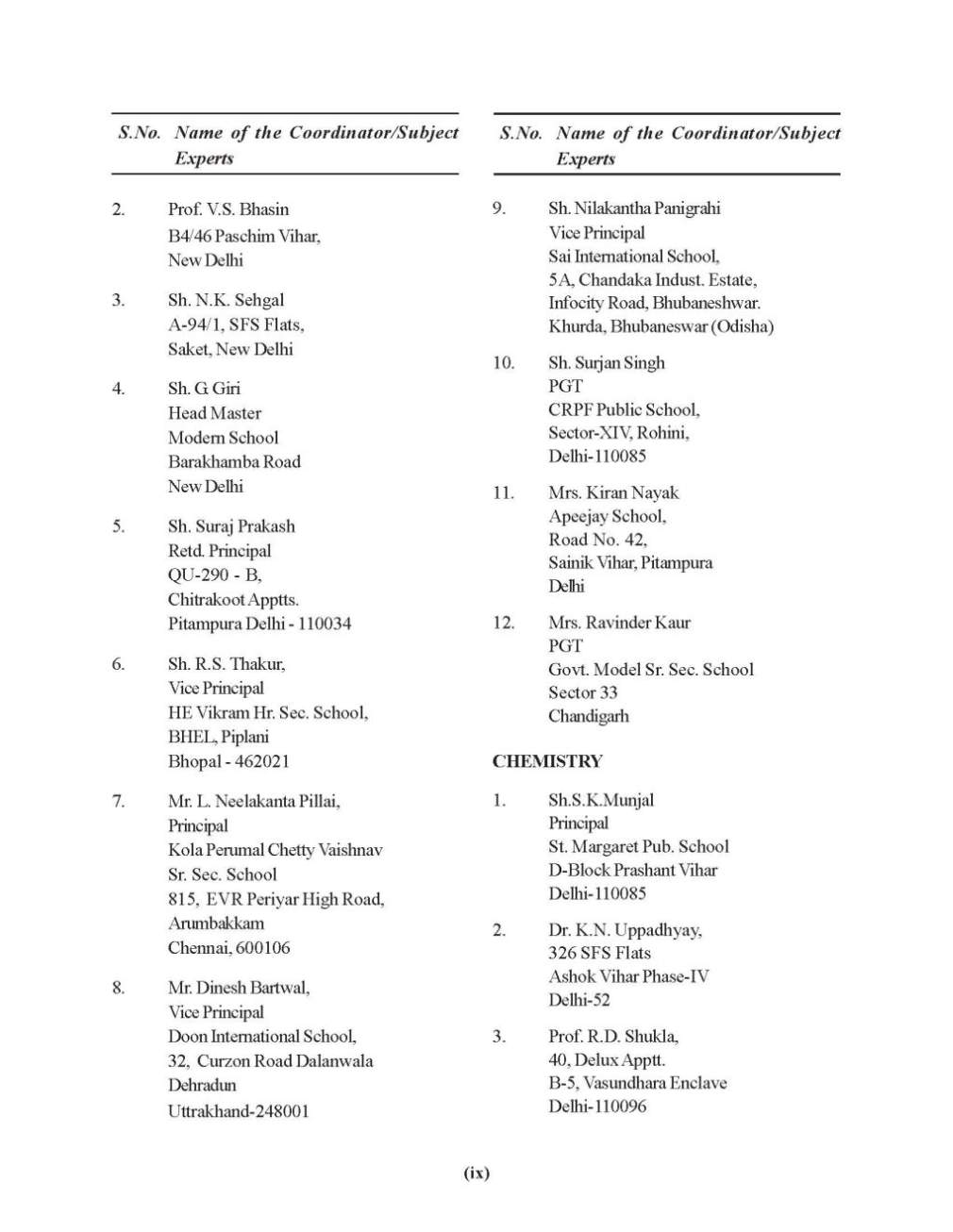
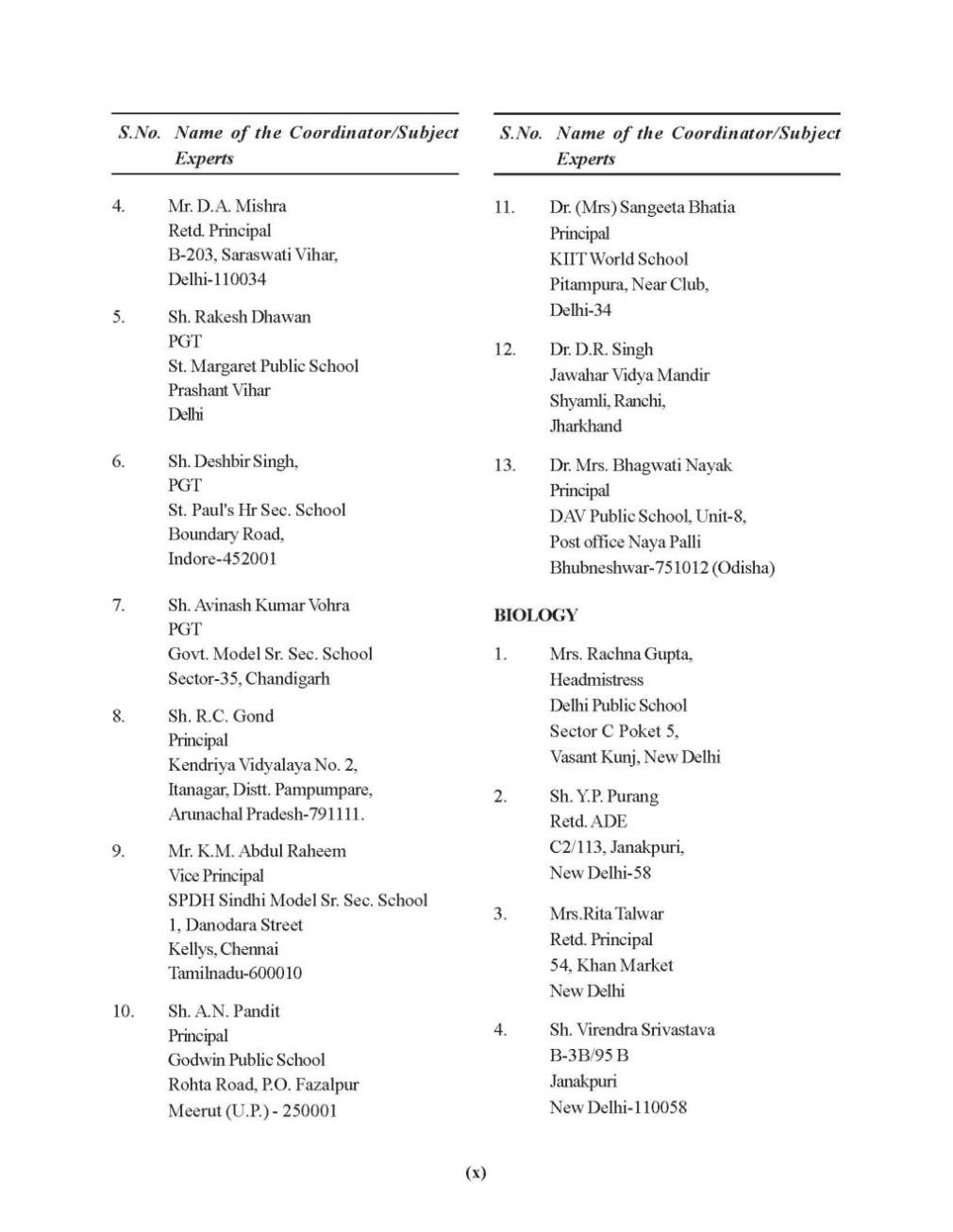




 ; Declaration of objects as instances of a class; accessing members from object(s), Objects as function arguments - pass by value and pass by reference;
; Declaration of objects as instances of a class; accessing members from object(s), Objects as function arguments - pass by value and pass by reference;